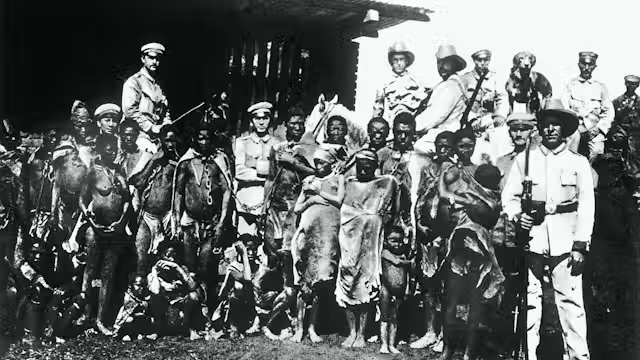The genocide of the Ovaherero and Nama peoples during German colonial rule in Namibia (1904–1907) has increasingly received attention in historical discourse and diplomatic negotiations. Yet, the brutal and systematic persecution that followed—targeting Namibia’s Bushmen, commonly referred to as the San—remains largely undocumented and marginalised in public memory. A new edition of anthropologist Robert J. Gordon’s seminal work, The Bushman Myth Revisited: Genocide, Dispossession and the Road to Servitude, reopens this chapter of Namibian history with academic rigour and socio-political urgency.
Originally published in 1992 as The Bushman Myth and the Making of a Namibian Underclass, the book was inaccessible to most Namibians due to its overseas publication. At the urging of San activists and local scholars, Gordon has now released a revised and affordable edition through the University of Namibia Press, ensuring that the historical record can be more readily examined and debated within the country itself.
The Bushmen, comprising more than 200 distinct ethnolinguistic groups native to the Kalahari Basin, represent some of the most ancient surviving cultures on Earth. Their hunter-gatherer society operated on principles of communal land use, reciprocal sharing, and minimal material accumulation. These values directly contradicted the colonial imperative of private property, labour exploitation, and hierarchical governance. Their resistance to wage labour and refusal to conform to settler norms rendered them, in the eyes of German authorities, a threat to colonial stability.
Following the genocidal campaigns against the Ovaherero and Nama, settler expansion intensified across the fertile north-eastern regions of the colony—particularly around Grootfontein, where settler farms grew from 15 in 1903 to 175 by 1913. These farms were established on Bushman-inhabited lands, and the increasing settler presence led to confrontations. In response to settler anxieties, colonial authorities framed the Bushmen not merely as trespassers but as insurgents and criminals. Headlines decrying a so-called “Bushman Plague” filled the colonial press, inflamed by isolated incidents such as the killing of settlers or the disruption of migrant labour routes to the diamond fields at Lüderitzbucht.

Between 1911 and 1913, over 400 anti-Bushman patrols were dispatched across approximately 60,000 square kilometres of territory. German colonial decrees authorised the summary execution of any Bushman deemed to be resisting arrest. However, the state’s actions were often outpaced by vigilante settler violence. These “Bushman hunts”—both formal and informal—continued until the South African occupation of the territory in 1915.
Although exact numbers are impossible to confirm, estimates cited by Gordon suggest a catastrophic demographic collapse. In 1913, colonial records placed the Bushman population between 8,000 and 12,000. By 1923, the number had fallen to approximately 3,600. Gordon attributes this sharp decline to the deliberate and systemic targeting of Bushmen, describing it as a form of genocide driven by what he calls the platzgeist—a fusion of zeitgeist (spirit of the times) and platz (place), reflecting the specific socio-psychological conditions of colonial settlers. These settlers, often former soldiers lacking agricultural expertise, faced harsh environmental and economic realities. Their perceived vulnerability bred paranoia and hyper-masculine responses to indigenous resistance.
Bushmen, with their reputed skills in tracking and their use of poison-tipped arrows, became symbolic of the settler’s deepest fears. Their extermination was rationalised through metaphors of predatory wildlife and racial superiority, further dehumanising them and making their eradication appear both logical and necessary within the colonial worldview.
South African rule following 1915 continued the legacy of dispossession, albeit in more bureaucratic and less overtly violent forms. Traditional Bushman weapons were criminalised, ancestral lands were turned into settler farms or game reserves, and colonial administrators proposed massive forced relocations to “Bushmanland”—a region representing only 2% of their former territorial range. Even during the 1970s, resettlement policies were actively discussed.
Post-independence Namibia has not reversed these trends. New labour laws made employing Bushmen economically unviable, leading to widespread dismissal and displacement. Many ended up in informal settlements or communal lands with minimal access to basic services or employment. Government responses have largely focused on welfare grants and overcrowded resettlement schemes. Meanwhile, popular images of Bushmen—used heavily in tourism marketing—portray them as timeless hunter-gatherers, reinforcing romanticised stereotypes while ignoring historical trauma.
Gordon’s work challenges these simplifications and reframes the Bushman experience within the broader context of colonial violence, settler expansionism, and systemic marginalisation. The book acts as both historical document and analytical tool, inviting further research and public engagement with a neglected part of Southern Africa’s past.
The publication of The Bushman Myth Revisited serves not only to correct historical omissions but also to provoke difficult conversations about the lingering structures of colonialism that continue to affect Indigenous communities in Namibia and beyond. In re-examining this overlooked genocide, Gordon contributes to a growing call for historical justice rooted in evidence, inclusion, and accountability.














